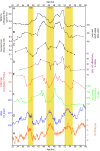Patagonian dust, Agulhas Current, and Antarctic ice-rafted debris contributions to the South Atlantic Ocean over the past 150,000 years
- PMID: 39042680
- PMCID: PMC11295081
- DOI: 10.1073/pnas.2402120121
Patagonian dust, Agulhas Current, and Antarctic ice-rafted debris contributions to the South Atlantic Ocean over the past 150,000 years
Abstract
Disentangling inputs of aeolian dust, ice-rafted debris (IRD), and eroded continental detritus delivered by ocean currents to marine sediments provide important insights into Earth System processes and climate. This study uses Sr-Nd-Pb isotope ratios of the continent-derived (lithogenic) fraction in deep-sea core TN057-6 from the subantarctic Southern Ocean southwest of Africa over the past 150,000 y to identify source regions and quantify their relative contributions and fluxes utilizing a mixing model set in a Bayesian framework. The data are compared with proxies from parallel core Ocean Drilling Program Site 1090 and newly presented data from potential South America aeolian dust source areas (PSAs), allowing for an integrated investigation into atmospheric, oceanic, and cryospheric dynamics. PSA inputs varied on glacial/interglacial timescales, with southern South American sources dominating up to 88% of the lithogenic fraction (mainly Patagonia, which provided up to 68%) during cold periods, while southern African sources were more important during interglacials. During the warmer Marine Isotope Stage (MIS) 3 of the last glacial period, lithogenic fluxes were twice that of colder MIS2 and MIS4 at times, and showed unique isotope ratios best explained by Antarctic-derived IRD, likely from the Weddell Sea. The IRD intrusions contributed up to 41% at times and followed Antarctic millennial warming events that raised temperatures, causing instability of icesheet margins. High IRD was synchronous with increased bioavailable iron, nutrient utilization, high biological productivity, and decreased atmospheric CO2. Overall, TN057-6 sediments record systematic Southern Hemisphere climate shifts and cryospheric changes that impacted biogeochemical cycling on both glacial/interglacial and subglacial timescales.
Keywords: Southern Ocean; climate; dust; ice-rafted debris; provenance.
Conflict of interest statement
Competing interests statement:The authors declare no competing interest.
Figures





References
-
- Winckler G., Anderson R. F., Fleisher M. Q., McGee D., Mahowald N. M., Covariant glacial-interglacial dust fluxes. Science 320, 93–96 (2008). - PubMed
-
- Lamy F., et al. , Increased dust deposition in the Pacific Southern Ocean during glacial periods. Science 343, 403–407 (2014). - PubMed
-
- Lambert F., Bigler M., Steffensen J. P., Hutterli M., Fischer H., Centennial mineral dust variability in high-resolution ice core data from Dome C, Antarctica. Clim. Past 8, 609–623 (2012).
-
- Martin J. H., Glacial-interglacial CO2 change: The iron hypothesis. Paleoceanography 5, 1–13 (1990).
-
- Tegen I., Miller R., A general circulation model study on the interannual variability of soil dust aerosol. J. Geophys. Res. 103, 25975–25995 (1998).
Grants and funding
LinkOut - more resources
Full Text Sources
Research Materials
Miscellaneous

